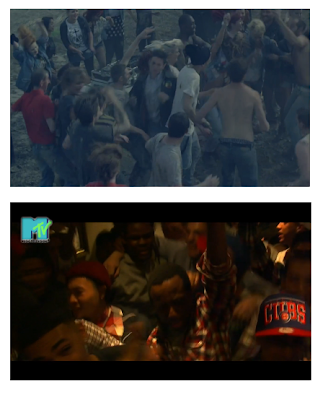Ayo
Fallin'
XL Recordings
In what ways does your media
product use, develop or challenge forms and conventions
of real media products?
Our video above certainly challenges conventional music video techniques, aspects and forms but also adheres to many of the conventions associated with music videos. Admittedly at the beginning of the process, the direction we wanted our video to take was blurred - the unsureness even resulted in us deciding to change the song we were using for the music video at the last minute from the original version to a remixed version of the song "Wilhelm Scream". Both versions of the track are displayed below:
ORIGINAL
REMIX
http://soundcloud.com/r-d-1/james-blake-the-wilhelm-scream
Influences on our final music video - came from a variety of sources. The decision to challenge traditional music video conventions such as a non-linear narrative and to have a major storyline in our music video came from the Rihanna video "We Found Love" featuring Calvin Harris. The music video has a clear narrative and storyline, and though it challenged conventional music video forms in reference to theorist Goodwin - we were willing to attempt this too and emulate the execution of the Rihanna video in out work.
Here are screenshots from both videos side by side - showing how we embedded intertextuality from the Rihanna video into our work.
Above are stills from a scene in Rihanna's "We Found Love" video and our "Fallin'" video. In our video we attempted to create the intimacy between the two main protagonists with a sensual embrace.
And again above the intertextuality is clear in that we attempted to recreate the atmosphere embodied in the party scene of the WFL video in our production.
_________________________________________________
Another example of intertextuality within our video would be the use of a motif, a form and convention that is used in many, many music video productions. Mark Ronson & The Business Int'l's "The Bike Song" uses the technique of having a clear motif through the video - and in their case - it was the use of Japanese fonts - something we used within out production too and a theme that was incorporated into our ancillary products - examples of this are below.
Above are two outtakes from the respective videos. Intertextuality of forms and conventions of real media products and our production are clear. The intertextuality and motif of Japanese writing is clear in our ancillary products also.
Above shows our use of the Japanese motif in our ancillary products. When creating a digipak it is common that the conventions and forms you incorporated into your music video and themes will be intertextualised into your ancillary work.
_________________________________________________
Above is a comparison image of the similar codes and conventions associated with a real media product album advertisement of Annie Lennox's upcoming album and our production. They both demonstrate the name of the artists and album clearly on the advert for consumers - and a clear, broad image of the artist - our picture is especially broader as it is our artists debut album - also purchasing avenues (iTunes, HMV) are bigger as commercial revenue generated from an emerging artist is more important to a label then a veteran such as Lennox. Also the ongoing theme of Japanese writing is again brought up again in our ancillary work.
Lastly - challenging traditional music video forms and conventions was an issue for our group - especially for our choice of shots - and our decision to incorporate out of focus shots for aesthetic preference. We addressed this issue in the production stage of our blogging also - but here are examples of our decision to challenge traditional filming choices in edit.
We had filmed these scenes in-focus but aesthetically the out of focus shots we believed added to the mystery of the situation and ambiguity.
_________________________________________________
Though we challenged conventions and traditional forms in our music video we did conform to the conventions and forms associated with music videos and in our ancillary products too.
This E.C.U used at the final stages of our music video represents what theorist Mulvey designates as the "male gaze" and the fact that E.C.U.'s are traditionally used on female artists and performers, we decided to adhere to that theory and convention.
Our ancillary products also follow the conventions associated with real media products for instance the inside panels for our digipak clearly show this.
The above comparison image is of my produced inside panel for my digipak and the inside pannel design of YMCMB Recording Artist Drake's sophomore album "Take Care". The inside panel contains an extensive break down of the production details and is a common occurrence in music releases and ancillary products.









No comments:
Post a Comment